Chevrolet Captiva Service & Repair Manual: Disc Brake Caliper R&I
Front
Removal
| Caution: Support the brake
caliper with heavy mechanic wire, or equivalent, whenever it is separated
from its mount and the hydraulic flexible brake hose is still connected.
Failure to support the caliper in this manner will cause the flexible brake
hose to bear the weight of the caliper, which may cause damage to the brake
hose and in turn may cause a brake fluid leak. |
| DO NOT use any air tools to remove
or install the guide pin bolts. Use hand tools ONLY. |
| Install an open end wrench to
hold the caliper guide pin in line with the brake caliper while removing
or installing the caliper guide pin bolt. DO NOT allow the open end wrench
to come in contact with the brake caliper. Allowing the open end wrench
to come in contact with the brake caliper will cause a pulsation when the
brakes are applied. |
| 1. |
Raise and support the vehicle. |
| 2. |
Remove the tire and wheel assembly. |
| 3. |
Remove the brake caliper guide pin
bolts (1). Hold the brake caliper guide pins stationary when removing
the guide pin bolts, Fig. 1. |
| 4. |
Without disconnecting the brake caliper
hose, remove the brake caliper and support with heavy mechanics
wire or equivalent. |
| 5. |
Remove the inner brake pad (1). Note
the location of the wear sensor for correct installation, Fig.
2. |
| 6. |
Remove the outer brake pad (2),
Fig. 2. |
| 7. |
Remove the brake pad shims (1),
Fig. 3. |
| 8. |
Remove the brake caliper bracket bolts
(1), Fig. 4. |
| 9. |
Remove the brake caliper bracket (1),
Fig. 5. |
|
Installation
| If reusing the caliper bracket
bolts the threads of the caliper bracket bolts and the threads of the knuckle
mounting holes must be free of residue and debris prior to application of
threadlocker in order to ensure proper adhesion and fastener retention. |
| DO NOT use any air tools to remove
or install the guide pin bolts. Use hand tools ONLY. |
| Install an open end wrench to
hold the caliper guide pin in line with the brake caliper while removing
or installing the caliper guide pin bolt. DO NOT allow the open end wrench
to come in contact with the brake caliper. Allowing the open end wrench
to come in contact with the brake caliper will cause a pulsation when the
brakes are applied. |
| 1. |
Install the brake caliper bracket. |
| 2. |
Prepare the bolts and the threaded
holes for assembly, noting following: |
| |
a. |
Thoroughly clean the residue from the
bolt threads by using denatured alcohol or equivalent and allow
to dry. |
| |
b. |
Thoroughly clean the residue from the
threaded holes with denatured alcohol or equivalent and allow to
dry. |
| |
c. |
Apply threadlocker GM part No. 12345493,
or equivalent to 2/3 of the threaded length of the lower caliper
bracket bolts. |
| |
d. |
Ensure there are no gaps in the threadlocker
along the length of the filled area of the bolts. |
| |
e. |
Allow the threadlocker to cure approximately
10 minutes before installation. |
| 3. |
Install the brake caliper bracket bolts
and torque to 89 ft. lbs. |
| 4. |
Install the brake pad shims. |
| 5. |
Install the inner brake pad. Note the
location of the wear sensor for correct installation. |
| 6. |
Install the outer brake pad. |
| 7. |
Position the brake caliper to the bracket. |
| 8. |
Holding the brake caliper guide pins
stationary, install the brake caliper guide pin bolts and torque
to 20 ft. lbs. |
| 9. |
Install the tire and wheel assembly. |
|
Rear
Removal
| Caution: Support the brake
caliper with heavy mechanic wire, or equivalent, whenever it is separated
from its mount and the hydraulic flexible brake hose is still connected.
Failure to support the caliper in this manner will cause the flexible brake
hose to bear the weight of the caliper, which may cause damage to the brake
hose and in turn may cause a brake fluid leak. |
| DO NOT use any air tools to remove
or install the guide pin bolts. Use hand tools ONLY. |
| Install an open end wrench to
hold the caliper guide pin in line with the brake caliper while removing
or installing the caliper guide pin bolt. DO NOT allow the open end wrench
to come in contact with the brake caliper. Allowing the open end wrench
to come in contact with the brake caliper will cause a pulsation when the
brakes are applied. |
| 1. |
Raise and support the vehicle. |
| 2. |
Remove the tire and wheel assembly. |
| 3. |
Remove the brake caliper guide pin
bolts (1). Hold the brake caliper guide pins stationary when removing
the guide pin bolts, Fig. 6. |
| 4. |
Without disconnecting the brake caliper
hose, remove the brake caliper and support with heavy mechanics
wire or equivalent. |
| 5. |
Remove the outer brake pad (1),
Fig. 7. |
| 6. |
Remove the inner brake pad (2). Note
the location of the wear sensor for correct installation, Fig.
7. |
| 7. |
Remove the brake pad shims (1),
Fig. 8. |
| 8. |
Remove the brake caliper bracket bolts
(1), Fig. 9. |
| 9. |
Remove the brake caliper bracket (1),
Fig. 10. |
|
Installation
| If reusing the caliper bracket
bolts the threads of the caliper bracket bolts and the threads of the knuckle
mounting holes must be free of residue and debris prior to application of
threadlocker in order to ensure proper adhesion and fastener retention. |
| DO NOT use any air tools to remove
or install the guide pin bolts. Use hand tools ONLY. |
| Install an open end wrench to
hold the caliper guide pin in line with the brake caliper while removing
or installing the caliper guide pin bolt. DO NOT allow the open end wrench
to come in contact with the brake caliper. Allowing the open end wrench
to come in contact with the brake caliper will cause a pulsation when the
brakes are applied. |
| 1. |
Install the brake caliper bracket. |
| 2. |
Prepare the bolts and the threaded
holes for assembly, noting following: |
| |
a. |
Thoroughly clean the residue from the
bolt threads by using denatured alcohol or equivalent and allow
to dry. |
| |
b. |
Thoroughly clean the residue from the
threaded holes with denatured alcohol or equivalent and allow to
dry. |
| |
c. |
Apply threadlocker GM part No. 12345493,
or equivalent to 2/3 of the threaded length of the lower caliper
bracket bolts. |
| |
d. |
Ensure there are no gaps in the threadlocker
along the length of the filled area of the bolts. |
| |
e. |
Allow the threadlocker to cure approximately
10 minutes before installation. |
| 3. |
Install the brake caliper bracket bolts
and torque to 89 ft. lbs. |
| 4. |
Install the brake pad shims. |
| 5. |
Install the outer brake pad. |
| 6. |
Install the inner brake pad. Note the
location of the wear sensor for correct installation. |
| 7. |
Position the brake caliper to the bracket. |
| 8. |
Holding the brake caliper guide pins
stationary, install the brake caliper guide pin bolts and torque
to 20 ft. lbs. |
| 9. |
Install the tire and wheel assembly. |
|
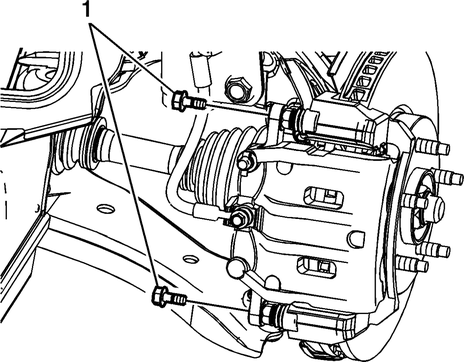
Fig.
1
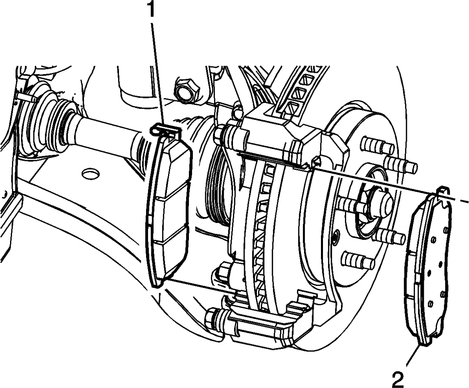
Fig.
2
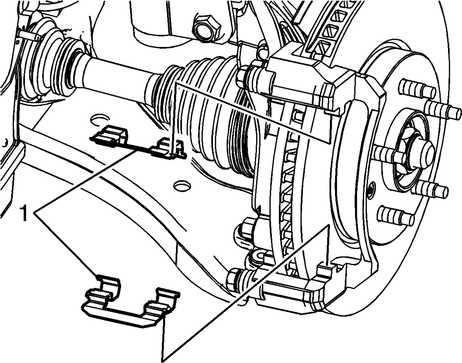
Fig.
3
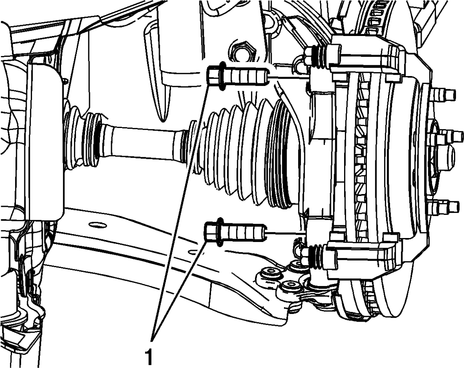
Fig.
4
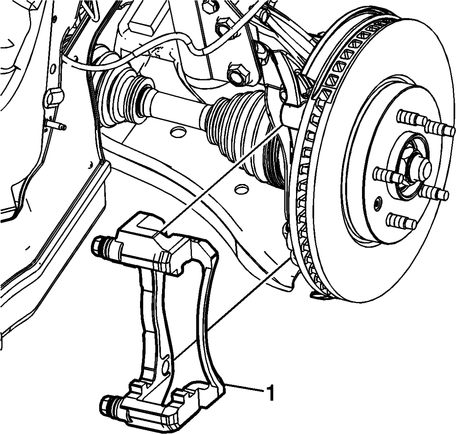
Fig.
5
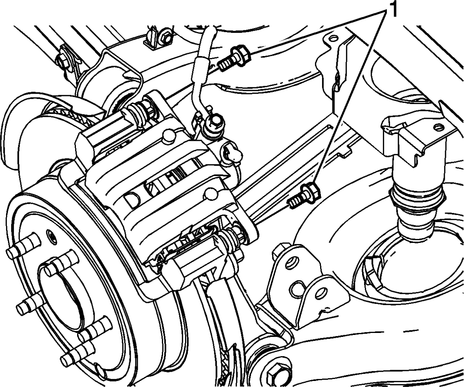
Fig.
6
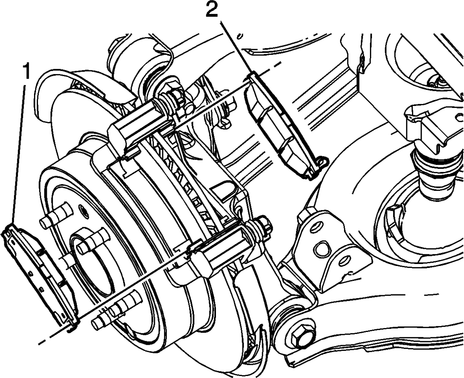
Fig.
7
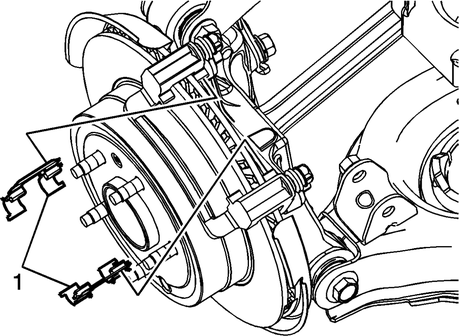
Fig.
8
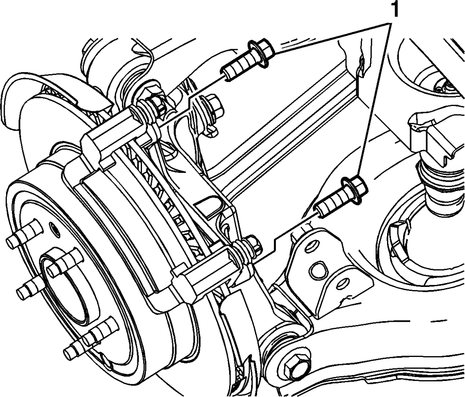
Fig.
9
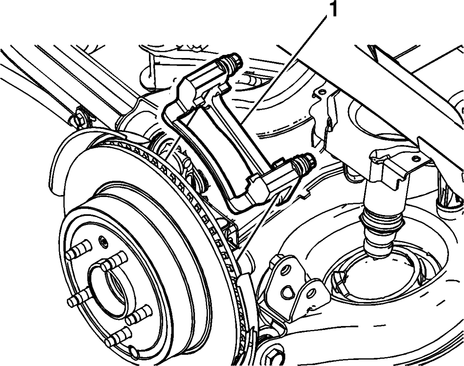
Fig. 10
Performing a Disc Brake Caliper R&I (Removal and Installation) on a Chevrolet Captiva (2006-2018) involves several precise steps outlined in the service and repair manual. This procedure is essential for maintaining proper brake function, ensuring safety and optimal braking performance.
Start by parking the vehicle on a level surface and engaging the parking brake. Put on safety gloves and eye protection before beginning the R&I process. Ensure the engine is turned off to prevent accidental engagement of the brakes during the procedure.
Locate the disc brake caliper on the wheel assembly you intend to work on. The caliper is typically mounted on the rotor and secured by bolts or slide pins. Before removing the caliper, use a suitable tool to compress the caliper piston slightly. This step makes it easier to remove the caliper from the rotor and allows for proper installation of new brake pads if necessary.
Next, carefully remove the caliper mounting bolts or slide pins using the appropriate wrench or socket. Take note of the caliper's orientation and position to ensure correct reinstallation later. Once the bolts are removed, gently pull the caliper away from the rotor and brake pads.
Inspect the caliper for any signs of damage, wear, or leakage that may require replacement or repair. If replacing the caliper, transfer any necessary components, such as brake pads or brake hose fittings, from the old caliper to the new one.
Install the new or refurbished caliper by aligning it with the rotor and brake pads. Insert the caliper mounting bolts or slide pins and tighten them securely to the manufacturer's specifications. Double-check all connections and ensure the caliper is properly aligned with the rotor.
After installing the caliper, pump the brake pedal a few times to restore brake pressure and verify that the brakes feel firm and responsive. Test drive the vehicle at low speeds to ensure proper brake function before returning it to regular use.
Front
Removal
Caution: Support the brake
caliper with heavy mechanic wire, or equivalent, whenever it is separated
from its mount and the hydraulic flexible brake hose is still connec ...
Front
Removal
Caution: Support the brake
caliper with heavy mechanic wire, or equivalent, whenever it is separated
from its mount and the hydraulic flexible brake hose is still connec ...
More about:
Chevrolet Captiva Owners Manual > Vehicle Checks: Battery
Refer to the replacement number
shown on the original battery label
when a new battery is needed. See
Engine Compartment Overview on
page 10-4 for battery location.
Warning
Battery posts, terminals, and
related accessories contain lead
and lead compounds, chemicals
known to the State of Cal ...










 Disc Brake Caliper Guide Pin R&R
Disc Brake Caliper Guide Pin R&R Disc Brake Caliper R&R
Disc Brake Caliper R&R